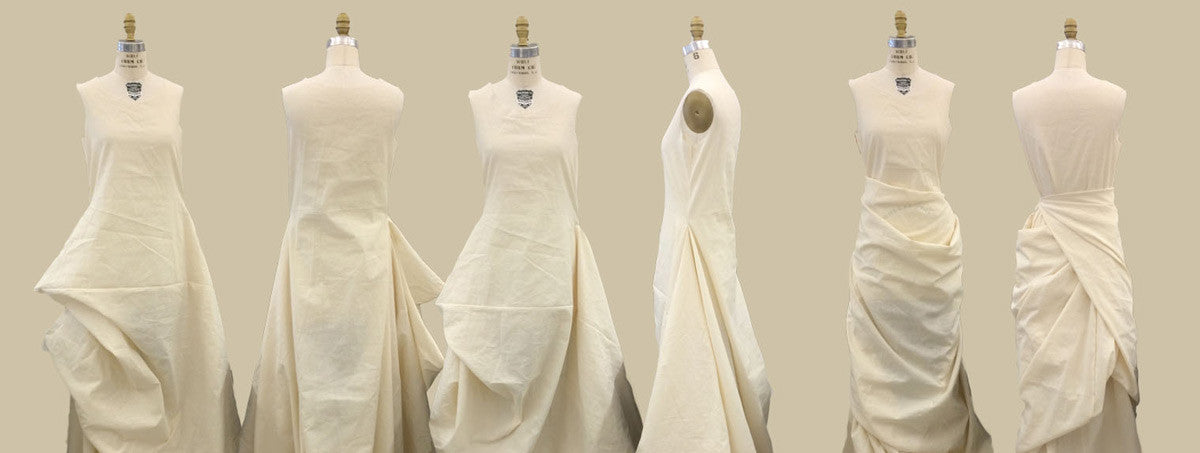Your Cart is Empty
Free Shipping On All Orders In December - No Coupon Code Necessary
Free Shipping On All Orders In December - No Coupon Code Necessary
Free Shipping On All Orders In December - No Coupon Code Necessary
Free Shipping On All Orders In December - No Coupon Code Necessary

July 12, 2017 3 min read
One of the most important parts of fashion design is fashion draping. It refers to the process of positioning and pinning fabric on a dress form, in order to create the structure of a clothing design. Basically, there are two ways for a fashion designer to create new designs at the beginning of the garment design process: one can either use a design sketch as a basis or can play with the way fabric falls. After the fashion designer finishes draping, he/she removes the fabric from the dress formand uses it to create the sewing pattern for what will result in a garment.
For fashion draping and fitting, it is usually recommended to use muslin. In case you don’t know yet, muslin is an unbleached, loosely woven cotton, which is also quite inexpensive. Using muslin for fashion draping and fitting helps to resolve any design and fitting issues that might appear in a garment, prior to cutting the pattern in your fabric that you’ll use for the garment.
However, you need to pay attention to the type of muslin that you choose. It is always recommended for your draping to use a muslin that gas similar drape characteristics as the final fabric that you’ll use for your real garment. As you will see, muslin is available in a variety of weights. Additionally, you can also use other inexpensive synthetic fabrics in draping and fitting for garment design.
 The process of fashion draping
The process of fashion draping
One of the first things you need to know before starting the actual process of fashion draping is that fashion designers drape garments in sections. This means that you can drape, for example, the front bodice, the back bodice, the front skirt and back skirt, and so on. Another thing to remember is that only the right side of the garment is draped. However, this is only available if the apparel design is asymmetrical.
Now it is time to tell you about the general process of fashion draping. So here is what you need to do.
In this step, you need to measure, tear, block, press and mark grain lines and reference lines.

Once you finished the preparing step, you can start the actual draping process. This involves pinning the fabric to the dress formand positioning it to form different darts, gathers, tucks and others alike, to give shape and fit to the garment.
So you achieved the desired design. Now, you can mark the muslin while it is still on the dress form, to point out where the darts, seam lines and other things are situated on the fabric.
Once you finish the marking, remove the muslin from the dress form and lay it flat on a table, to prepare it for truing.
During this process, you use rulers and design curves to connect, smooth out and finalize the markings you did on your muslin.
Pin the muslin together with all darts pinned and then place it back onto your dress form.This helps you to check for fit accuracy. It also enables you to drape any extra parts of the garment.
You checked the muslin for fit accuracy, and you are satisfied with the appearance and fit of your pinned garment. Now you can remove the muslin from the dress formand press it flat. Transfer all seam lines, grain lines, notches, markings and so on to paper. Now your sewing pattern for the garment is created!
The importance of draping for fashion designers
Maybe you still wonder why is it important for a fashion designer to learn how to drape. The answer is simple: draping allows fashion designers to understand what makes a great fit and how can they accomplish it. Just imagine how a poorly fit garment sample looks like. Although a beginner might not observe this, one who is familiar with how seams and darts give shape to clothes can easily notice every fit issue of the garment.
Besides, draping allows the fashion designer to immediately correct any design or fit issues, prior to putting anything down on paper. Additionally to these reasons, there is also another one: some fabrics need to be experimented with on a dress form to observe how they behave.
Conclusion
In conclusion, draping is an important process, as it helps fashion designers to experiment with fabric, to use their creativity to see where darts, tucks and other design elements fit better, and to play with the way fabric behaves on the body.